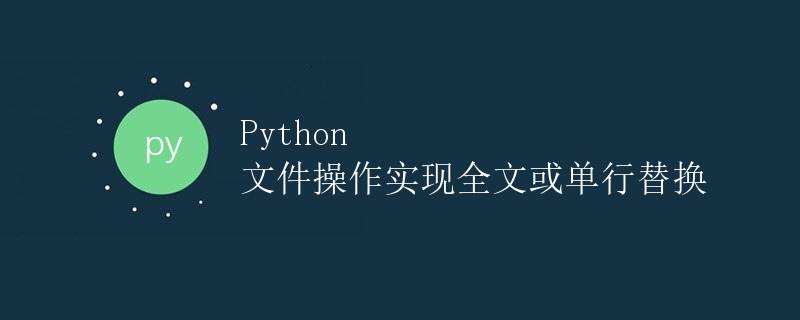Python 文件操作实现全文或单行替换

介绍
在日常的编程过程中,我们经常会遇到需要对文件进行内容替换的情况。当我们需要修改文件中的某个单词、字符或者一整行内容时,手动打开文件并进行替换是一件重复而繁琐的事情。而利用 Python 的文件操作功能,我们可以简单快速地实现对文件进行全文或单行替换的功能。
本文将详细介绍如何使用 Python 的文件操作方法来实现文件内容的替换功能,并提供相关的示例代码和演示结果。
文件操作方法
Python 提供了多种方法来执行文件操作,包括文件的读取、写入、修改等操作。在本文中,我们将主要使用以下几种方法来实现文件内容的替换功能:
open()函数:用于打开文件,可以指定文件的打开模式(读取、写入、追加等)和字符编码。read()方法:用于读取文件的全部内容。write()方法:用于向文件写入内容。close()方法:用于关闭文件。
在使用这些方法时,我们还可以结合其他的字符串处理方法,比如 replace() 用于实现具体的替换操作。
全文替换
读取文件内容
首先,我们需要打开并读取待替换的文件。通过使用 open() 函数和 read() 方法,我们可以很方便地读取文件的全部内容。以下是一个简单的示例代码:
file_path = 'example.txt' # 文件路径
with open(file_path, 'r') as file:
content = file.read()
在上述代码中,我们首先指定了待替换文件的路径,并使用 open() 函数以只读模式打开文件。然后,通过 read() 方法读取文件的全部内容,并将其赋值给变量 content。
替换文件内容
读取文件内容后,我们可以使用字符串的 replace() 方法来实现全文替换。该方法用于将指定的字符串替换为另一个字符串。以下是一个示例代码:
old_str = 'old content'
new_str = 'new content'
new_content = content.replace(old_str, new_str)
在上述代码中,我们通过 replace() 方法将变量 content 中的字符串 old_str 替换为 new_str,并将替换后的内容赋值给新的变量 new_content。
写入文件
替换文件内容后,我们需要将更新后的内容写入文件。我们可以通过使用 write() 方法将变量的值写入到文件中。以下是一个示例代码:
with open(file_path, 'w') as file:
file.write(new_content)
在上述代码中,我们使用 open() 函数以写入模式打开文件,并通过 write() 方法将变量 new_content 的值写入到文件中。
单行替换
除了全文替换外,有时我们也需要对文件中的单行内容进行替换。以下是实现单行替换的步骤和示例代码:
逐行读取文件
首先,我们需要逐行读取文件内容以查找需要替换的行。我们可以使用 readlines() 方法将文件的内容行逐行读取到一个列表中。以下是一个示例代码:
with open(file_path, 'r') as file:
lines = file.readlines()
在上述代码中,我们使用 open() 函数以只读模式打开文件,并使用 readlines() 方法将文件的内容逐行读取到列表 lines 中。
替换指定行
读取文件内容后,我们可以使用列表的索引访问和修改指定的行。通过遍历列表,我们可以找到需要替换的行,并使用 replace() 方法进行替换。以下是一个示例代码:
line_number = 3 # 需要替换的行号
old_line = 'old line content'
new_line = 'new line content'
for i, line in enumerate(lines):
if i == line_number - 1:
lines[i] = line.replace(old_line, new_line)
在上述代码中,我们遍历了列表 lines 中的每一行内容,并使用 replace() 方法将指定行中的字符串 old_line 替换为 new_line。
写入文件
替换指定行后,我们需要将更新后的内容写入文件。我们可以通过使用 write() 方法将列表中的每一行写入到文件中。以下是一个示例代码:
with open(file_path, 'w') as file:
file.writelines(lines)
在上述代码中,我们使用 open() 函数以写入模式打开文件,并使用 writelines() 方法将列表 lines 中的每一行内容写入到文件中。
示例代码运行结果
为了更好地理解和验证上述代码的正确性,下面我们将使用一个示例文件进行替换操作,并展示运行结果。
示例文件内容如下(example.txt):
Hello, world!
This is an example file.
It contains some old content.
I want to replace it with new content.
全文替换示例
假设我们要将全文中的字符串 old content 替换为 new content,以下是示例代码的运行结果:
file_path = 'example.txt'
with open(file_path, 'r') as file:
content = file.read()
old_str = 'old content'
new_str = 'new content'
new_content = content.replace(old_str, new_str)
with open(file_path, 'w') as file:
file.write(new_content)
运行结果如下(example.txt):
Hello, world!
This is an example file.
It contains some new content.
I want to replace it with new content.
单行替换示例
假设我们要将第 3 行内容中的字符串 old content 替换为 new content,以下是示例代码的运行结果:
file_path = 'example.txt'
with open(file_path, 'r') as file:
lines = file.readlines()
line_number = 3
old_line = 'old content'
new_line = 'new content'
for i, line in enumerate(lines):
if i == line_number - 1:
lines[i] = line.replace(old_line, new_line)
with open(file_path, 'w') as file:
file.writelines(lines)
运行结果如下(example.txt):
Hello, world!
This is an example file.
It contains some new content.
I want to replace it with new content.
结论
通过使用 Python 的文件操作方法,我们可以很方便地实现对文件内容的全文或单行替换。无论是全文替换还是单行替换,我们都可以结合其他字符串处理方法来实现具体的替换操作。这种方法不仅简单快捷,还可以提高我们的工作效率。
 极客教程
极客教程